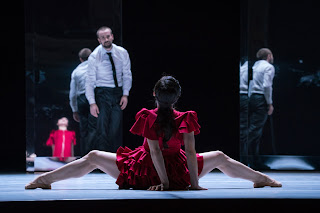 |
| Carmen Semperoper Ballet Dresden.Photo: Ian Whalen |
Carmen.
Choreographer Johan
Inger. Production director Gamal Gouda. . Lightim Music Georges Bizet, Rodion
Schtschedrin. Original additional music Marc Alvarez. Costume design David
delfin. Set design Curt Allen Wilmer. Lighting design Tom Visser. Choreographic
assistants Urtzi Aranburu, Patricia Vazquez Iruretagoyena. Ballet Masters Gamal
Gouda (Principals) Carmen Piqueras (Group) Dramaturgy Gregor Acuna-Pohl.
Semperoper Ballet Dresden. Artistic Director. Aaron S. Watkin. Recording
Bizet/Schtschedrin: Saechsiche Staatskapelle Dresden. Conductor: Thomas Herzog.
Festival Theatre. Adelaide Festival centre. Adelaide Festival March 8-10
Reviewed by Peter Wilkins
 |
| Ayaha Tsunaki is Carmen. Photo Ian Whalen |
Johan Inger is to ballet what
Barrie Kosky is to opera. From the
thunderous opening bars of George Bizet’s Carmen
before the curtain rises one feels a sense of thrilling excitement, of bold
invention and heart pumping expectation. Inger’s driving vision fulfils all
this and so much more withSemperoper Ballet Dresden’s magnificent balletic
interpretation of the story of the Sevillian cigarette factory worker whose
powerful sexual allure incites the deadly passions of obsessive desire and
jealous rage.
 |
Jon Vallejo as Don Jose Photo: Ian Whalen
|
A young boy enters with a
ball. A dark figure of portentous
destiny appears and the curtain rises to reveal the guarded gates at the front
of the cigarette factory. Inger’s Carmen
is no faithful adherent to previous interpretations of the classic myth. His is
a more portentious vision. Set against Curt Allen Wilmer’s astonishing design
of moving structures to represent, factory gates, cells, mountains and moving rectangular boxes as
represention of the urgency of Don Jose’s escalating obsession, Inger’s thrilling
choreography combines the exquisite gracefulness of ballet with the
inventiveness and ground breaking radicalism of contemporary dance and the
sheer muscularity and energy of physical theatre, The pas de trois with the
captivating Ayaha Tsunaki as the seductive Carmen, Jon Vallejo as the beguiled
Don Jose and Gareth Haw’s arrogant and
powerful Officer Zuniga. is more than a beautifully executed dance, but also an
expression of status in dance. The first half of the ballet with its colour,
spontaneity and the sheer vitality of Carmen’s red dress and the the sparkling
jacket of the charismatic Toreador ( Christian Bauch) is a celebration of the
fiery spirit of Bizet’s music and the Spanish
character.
In the second half, the prophetic destiny of
Don Jose’s descent into homicidal obsession presents a far darker aspect of the
tragedy. It is the dolour of the Duende. Inger’s choreography departs from the
aerial vitality of the dance of the toreadors to the despairing floor work of
the tormented Don Jose. The innocent child watches on, powerless to affect the
deadly consequence. The corps de ballet scramble across the stage as baying
dogs, ready to snap and snarl at the spoils of destruction. Bizet gives way to
the darker moods of Marc Alvarez’s sombre composition of impending doom and Tom
Visser’s lighting lends a darker aspect to destiny’s inevitability.
Inger’s Carmen is no homage to past performances of the iconic opera. This
is his intelligent re-imagining of the vulnerability of human nature. His
choreography is visceral, and we feel the rivalry of the factory women, the
machismo of the officers and the superiority and egotism of the toreadors. This
is Inger’s brilliance, to fuse the many expressions of dance according to the
emotive power of individual experience. His dancers embrace the vision with
fervor. The styles excite the imagination, visually and emotionally.
 |
| Anna Merkulova, Jon Vallejo, Ayaha Tsunaki. |
Ayaha’s Tsunaki’s Carmen is
electrifying. Her seduction of Don Jose and Zuniga is tantalizing, erotic and
willful as she leans back spread legged upon the floor or wraps herself around
her victim with tempting intent. She epitomizes the sexual power of the woman
and the unwitting agent of a violent and deadly destiny.
 |
| Joseph Hernandez,Ayaha Tsunaki, Jon Vallejo |
From the vicious confrontation of
Carmen with another factory worker, or the sensuous teasing of Don Jose or the
Toreador or the frantic pursuit between the moving towers of the set, Inger’s
reinvention interprets a new language for the dance. Supplemented by
Schtschedrin’s contemporary score, Bizet’s composition reveals a more complex
motif. Semperoper Ballett’s Carmen
defines a new and invigorating experiment in corporeal interpretation of myth
and motive. It is th, Ayaha Tsunakirilling, illuminating and exciting. The familiarity of
Bizet’s composition and the universally well-known story of Carmen and Don Jose
appear as if realized for the very first time by a company that is certain to
be the highlight event of the Adelaide Festival, alongside Barrie Kosky’s The Magic Flute.
The lengthy ecstatic
standing ovations that both works received say it all!!
Photos by Ian Whalen
